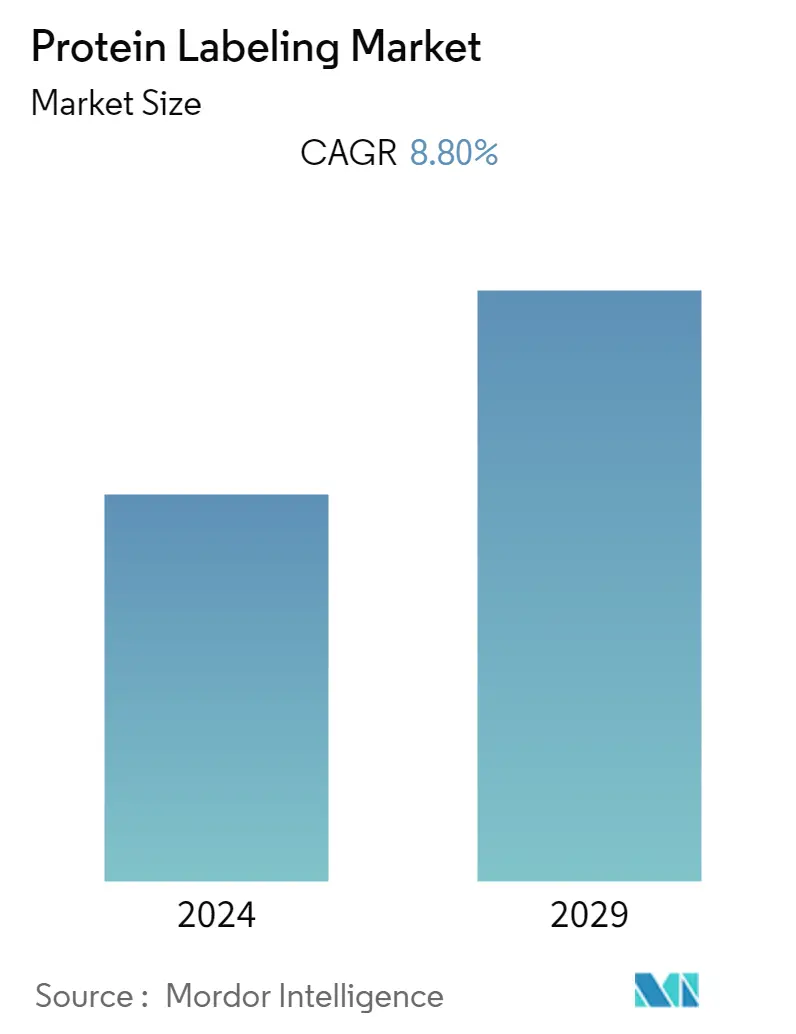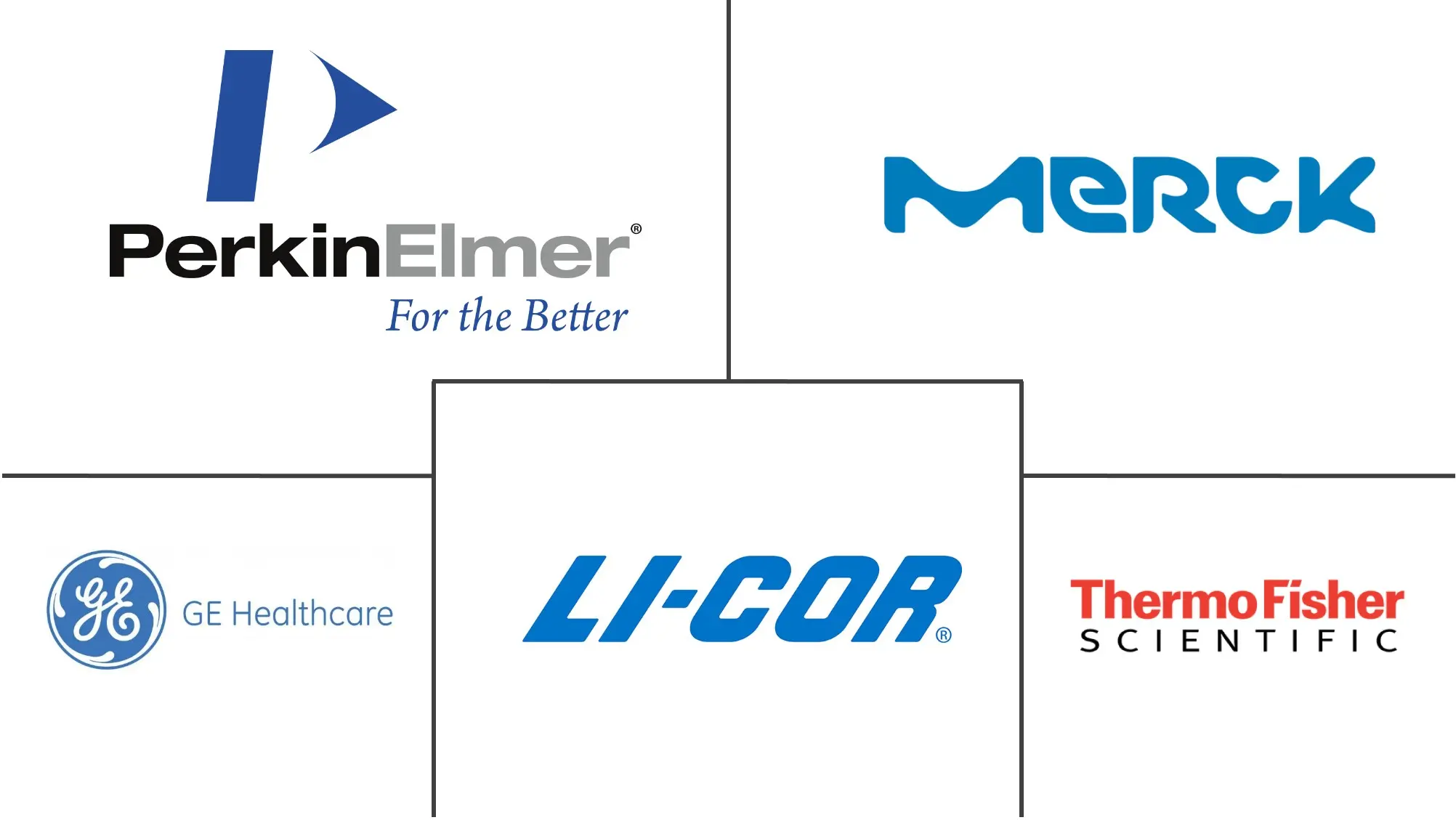Market Size of Protein Labeling Industry

| Study Period | 2019 - 2029 |
| Base Year For Estimation | 2023 |
| Forecast Data Period | 2024 - 2029 |
| CAGR | 8.80 % |
| Fastest Growing Market | Asia Pacific |
| Largest Market | North America |
Major Players
*Disclaimer: Major Players sorted in no particular order |
Protein Labelling Market Analysis
Proteins are the largest and most important biomolecules in a living organism, as they are vital to the functioning of an organism. Once they are formed within a cell, proteins interact with other biomolecules and carry out roles to keep the cell alive. Therefore, more importance is given to research the protein binding mechanism through specialized fields of studies, such as proteomics and protein chemistry.
Most of these techniques focus on the ability to specifically tag proteins by creating genetic fusions, and thereby, imparting distinctive properties for selective protein visualization, manipulation, and entrapment within complex biochemical environments. Various strategies are used to carry out successful protein labeling.
Protein Labelling Industry Segmentation
As per the scope of the report, protein labeling refers to the use of the appropriate molecular labels to detect or purify the labelled protein and its binding partners. Labeling strategies result in the covalent attachment of different molecules, including biotin, reporter enzymes, fluorophores and radioactive isotopes, to the target protein or nucleotide sequence
| By Product | |
| Reagents & Kits | |
| Services | |
| Other Products |
| By Application | |
| Immunological Techniques | |
| Cell-based Assays | |
| Fluorescence Microscopy | |
| Protein Microarrays | |
| Mass Spectrometry |
| By Labeling Method | |
| In-vitro Labeling | |
| In-vivo Labeling |
| Geography | ||||||||
| ||||||||
| ||||||||
| ||||||||
| ||||||||
|
Protein Labeling Market Size Summary
The protein labeling market is experiencing significant growth due to its critical role in biological research and applications. Proteins, being essential biomolecules, are extensively studied through techniques like proteomics and protein chemistry, which focus on tagging proteins to study their interactions and functions. Fluorescent tagging is a prominent method used in this field, where a fluorophore is attached to a protein to facilitate its detection and analysis. This technique is crucial for various applications, including immunochemistry, cell tracing, and fluorescence spectroscopy, among others. The increasing demand for these applications is driving the expansion of the protein labeling market.
In North America, particularly in the United States and Canada, the protein labeling market is bolstered by a robust healthcare system and supportive research policies. These factors attract global market players, enhancing the region's market presence. The region's growth is further supported by the rising adoption of personalized medicine and genomic sequencing. Meanwhile, the Asia-Pacific region is witnessing the emergence of smaller players, contributing to market growth through increased awareness. Major companies like GE Healthcare, Thermo Fisher Scientific Inc, and Merck KGaA dominate the market, leveraging their research capabilities and distribution networks to maintain a competitive edge.
Protein Labeling Market Size - Table of Contents
-
1. MARKET DYNAMICS
-
1.1 Market Overview
-
1.2 Market Drivers
-
1.2.1 Increasing R&D Expenditure for the Development of Protein Labeling
-
1.2.2 Increasing Proteomics Research
-
-
1.3 Market Restraints
-
1.3.1 Lack of Skilled Professionals
-
-
1.4 Porter's Five Force Analysis
-
1.4.1 Threat of New Entrants
-
1.4.2 Bargaining Power of Buyers/Consumers
-
1.4.3 Bargaining Power of Suppliers
-
1.4.4 Threat of Substitute Products
-
1.4.5 Intensity of Competitive Rivalry
-
-
-
2. MARKET SEGMENTATION
-
2.1 By Product
-
2.1.1 Reagents & Kits
-
2.1.2 Services
-
2.1.3 Other Products
-
-
2.2 By Application
-
2.2.1 Immunological Techniques
-
2.2.2 Cell-based Assays
-
2.2.3 Fluorescence Microscopy
-
2.2.4 Protein Microarrays
-
2.2.5 Mass Spectrometry
-
-
2.3 By Labeling Method
-
2.3.1 In-vitro Labeling
-
2.3.2 In-vivo Labeling
-
-
2.4 Geography
-
2.4.1 North America
-
2.4.1.1 United States
-
2.4.1.2 Canada
-
2.4.1.3 Mexico
-
-
2.4.2 Europe
-
2.4.2.1 Germany
-
2.4.2.2 United Kingdom
-
2.4.2.3 France
-
2.4.2.4 Italy
-
2.4.2.5 Spain
-
2.4.2.6 Rest of Europe
-
-
2.4.3 Asia-Pacific
-
2.4.3.1 China
-
2.4.3.2 Japan
-
2.4.3.3 India
-
2.4.3.4 Australia
-
2.4.3.5 South Korea
-
2.4.3.6 Rest of Asia-Pacific
-
-
2.4.4 Middle-East and Africa
-
2.4.4.1 GCC
-
2.4.4.2 South Africa
-
2.4.4.3 Rest of Middle East and Africa
-
-
2.4.5 South America
-
2.4.5.1 Brazil
-
2.4.5.2 Argentina
-
2.4.5.3 Rest of South America
-
-
-
Protein Labeling Market Size FAQs
What is the current Protein Labeling Market size?
The Protein Labeling Market is projected to register a CAGR of 8.80% during the forecast period (2024-2029)
Who are the key players in Protein Labeling Market?
GE Healthcare, Thermo Fisher Scientific Inc, Merck KGaA, Perkinelmer Inc and LI-COR Biosciences are the major companies operating in the Protein Labeling Market.

